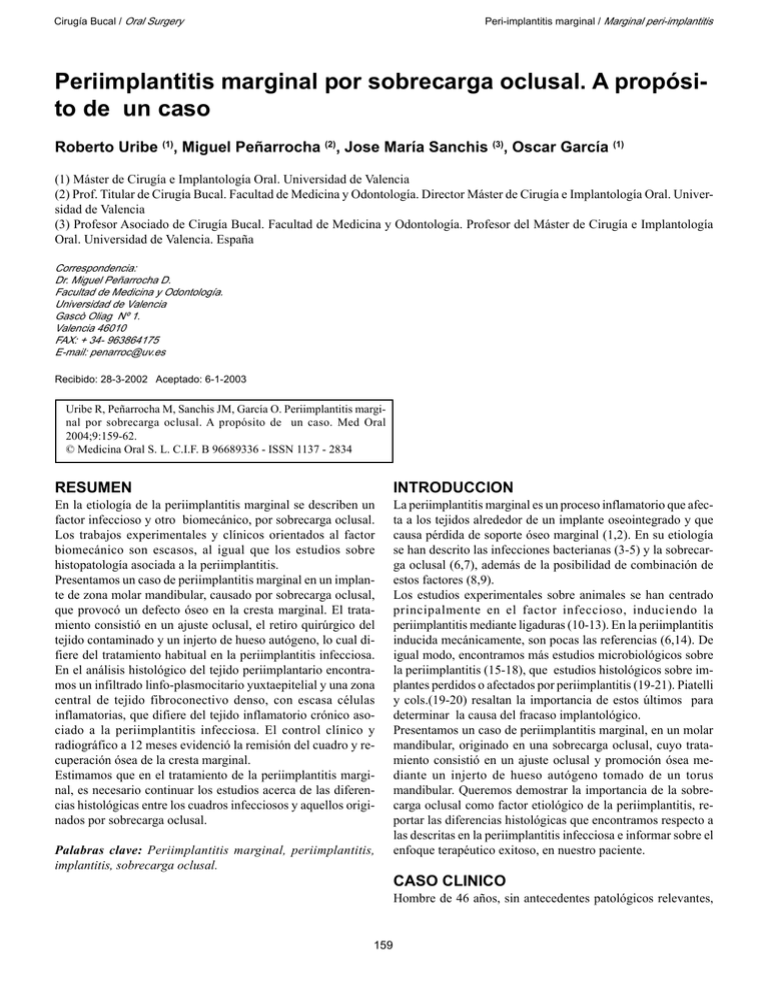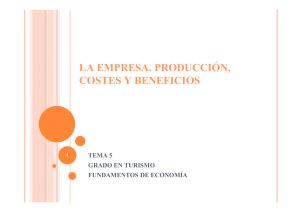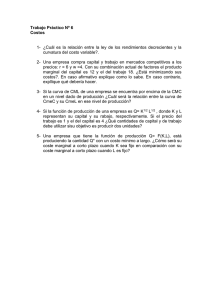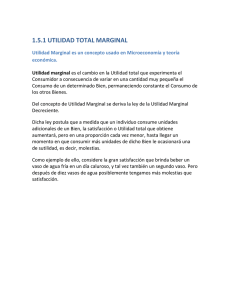Periimplantitis marginal por sobrecarga oclusal. A propósi
Anuncio

Cirugía Bucal / Oral Surgery Peri-implantitis marginal / Marginal peri-implantitis Periimplantitis marginal por sobrecarga oclusal. A propósito de un caso Roberto Uribe (1), Miguel Peñarrocha (2), Jose María Sanchis (3), Oscar García (1) (1) Máster de Cirugía e Implantología Oral. Universidad de Valencia (2) Prof. Titular de Cirugía Bucal. Facultad de Medicina y Odontología. Director Máster de Cirugía e Implantología Oral. Universidad de Valencia (3) Profesor Asociado de Cirugía Bucal. Facultad de Medicina y Odontología. Profesor del Máster de Cirugía e Implantología Oral. Universidad de Valencia. España Correspondencia: Dr. Miguel Peñarrocha D. Facultad de Medicina y Odontología. Universidad de Valencia Gascò Oliag Nº 1. Valencia 46010 FAX: + 34- 963864175 E-mail: [email protected] Recibido: 28-3-2002 Aceptado: 6-1-2003 Uribe R, Peñarrocha M, Sanchis JM, García O. Periimplantitis marginal por sobrecarga oclusal. A propósito de un caso. Med Oral 2004;9:159-62. © Medicina Oral S. L. C.I.F. B 96689336 - ISSN 1137 - 2834 RESUMEN INTRODUCCION En la etiología de la periimplantitis marginal se describen un factor infeccioso y otro biomecánico, por sobrecarga oclusal. Los trabajos experimentales y clínicos orientados al factor biomecánico son escasos, al igual que los estudios sobre histopatología asociada a la periimplantitis. Presentamos un caso de periimplantitis marginal en un implante de zona molar mandibular, causado por sobrecarga oclusal, que provocó un defecto óseo en la cresta marginal. El tratamiento consistió en un ajuste oclusal, el retiro quirúrgico del tejido contaminado y un injerto de hueso autógeno, lo cual difiere del tratamiento habitual en la periimplantitis infecciosa. En el análisis histológico del tejido periimplantario encontramos un infiltrado linfo-plasmocitario yuxtaepitelial y una zona central de tejido fibroconectivo denso, con escasa células inflamatorias, que difiere del tejido inflamatorio crónico asociado a la periimplantitis infecciosa. El control clínico y radiográfico a 12 meses evidenció la remisión del cuadro y recuperación ósea de la cresta marginal. Estimamos que en el tratamiento de la periimplantitis marginal, es necesario continuar los estudios acerca de las diferencias histológicas entre los cuadros infecciosos y aquellos originados por sobrecarga oclusal. La periimplantitis marginal es un proceso inflamatorio que afecta a los tejidos alrededor de un implante oseointegrado y que causa pérdida de soporte óseo marginal (1,2). En su etiología se han descrito las infecciones bacterianas (3-5) y la sobrecarga oclusal (6,7), además de la posibilidad de combinación de estos factores (8,9). Los estudios experimentales sobre animales se han centrado principalmente en el factor infeccioso, induciendo la periimplantitis mediante ligaduras (10-13). En la periimplantitis inducida mecánicamente, son pocas las referencias (6,14). De igual modo, encontramos más estudios microbiológicos sobre la periimplantitis (15-18), que estudios histológicos sobre implantes perdidos o afectados por periimplantitis (19-21). Piatelli y cols.(19-20) resaltan la importancia de estos últimos para determinar la causa del fracaso implantológico. Presentamos un caso de periimplantitis marginal, en un molar mandibular, originado en una sobrecarga oclusal, cuyo tratamiento consistió en un ajuste oclusal y promoción ósea mediante un injerto de hueso autógeno tomado de un torus mandibular. Queremos demostrar la importancia de la sobrecarga oclusal como factor etiológico de la periimplantitis, reportar las diferencias histológicas que encontramos respecto a las descritas en la periimplantitis infecciosa e informar sobre el enfoque terapéutico exitoso, en nuestro paciente. Palabras clave: Periimplantitis marginal, periimplantitis, implantitis, sobrecarga oclusal. CASO CLINICO Hombre de 46 años, sin antecedentes patológicos relevantes, 159 Peri-implantitis marginal / Marginal peri-implantitis Med Oral 2004;9:159-62.. no fumador. Se le realizó una rehabilitación fija sobre un implante unitario ( ITI® SLA. Straumann. Walderburg-Switzerland ) colocado en zona de 3.6. A los 6 meses de cementada la corona, acudió a control sin relatar sintomatología asociada. Al examen clínico se detectó un leve enrojecimiento de la mucosa adyacente al implante y una bolsa periimplantaria de 6 mm de profundidad, con leve sangramiento al sondaje. El papel de articular mostró un contacto prematuro sobre corona protésica. En la radiografía panorámica se observó un área radiotransparente en el hueso marginal a 3.6 (Fig. 1). Se realizó el tallado oclusal de la corona protésica. Posteriormente, se levantó un colgajo mucoperióstico desde 3.5 a 3.7, observándose un rodete de tejido blando de aspecto fibroso que ocupaba un defecto óseo periimplantario marginal a 3.6 (Fig. 2). Se procedió a retirar el tejido patológico con curetas plásticas y fue enviado a estudio anatomopatológico. La superficie del implante se descontaminó con gel de clorhexidina al 0.2% durante 2 minutos e irrigación con suero fisiológico. El colgajo fue ampliado para acceder a un torus mandibular lingual en zona de premolares ipsilateral, el cual se extrajo y particuló para servir de autoinjerto. El colgajo fue reposicionado y se suturó con seda 3.0. El paciente fue reinstruido en higiene oral, se prescibió ibuprofeno 600 mg cada 8 hrs x 4 días y colutorios con digluconato de clorhexidina al 0.12% 2 veces al día x 2 semanas. El análisis histopatológico evidenció un tejido epitelioconectivo, con abundante infiltrado linfo-plasmocitario yuxtaepitelial. Bajo la zona superficial, se apreció un tejido fibroconectivo denso con escasa células inflamatorias. A los 12 meses de realizado el tratamiento quirúrgico, en una radiografía se observó la recuperación ósea marginal (Fig. 3) y un aspecto clínico de normalidad, con ausencia de sintomatología. sistémicos son importantes. La etiología biomecánica de la periimplantitis, en nuestro caso, nos hizo considerar la eliminación del supracontacto, el autoinjero óseo y el uso de antiséptico tópico como terapia elegir, lo cual se diferencia de los tratamientos, a similar destrucción ósea, descritos en la literatura (24). El estudio histológico del tejido encontrado sobre el defecto óseo periimplantario, reflejó un predominio fibroconectivo, sobre el inflamatorio, lo que difiere de los hallazgos informados por Piattelli y cols. (19,20) en 54 implantes pérdidos por periimplantitis, en los cuales observan secuestros óseos sobre la superficie implantaria, en el 10% de los casos; la presencia de gran cantidad de bacterias y un infiltrado inflamatorio crónico (macrófagos, linfocitos y células plasmáticas). Sin embargo se asemeja bastante a la descripción, dada por los mismos autores, acerca de su estudio histológico en implantes extraídos por movilidad clínica, en los cuales observan un tejido conectivo fibroso denso en la interfase diente-implante, con ausencia de células inflamatorias. Coincidimos con ellos, respecto a la importancia de los hallazgos histológicos para determinar las causas de fracasos implantológicos. ENGLISH Marginal peri-implantitis due to occlusal overload. A case report URIBE R, PEÑARROCHA M, SANCHIS JM, GARCÍA O. MARGINAL PERIIMPLANTITIS DUE TO OCCLUSAL OVERLOAD. A CASE REPORT. MED ORAL 2004;9:159-62. DISCUSION La sobrecarga oclusal en el implante puede originar pérdida ósea marginal (10,12-14). Microfracturas dan origen a un defecto óseo sin fenómenos inflamatorios añadidos (22). Sin embargo Hurzeler y cols.(23), en un trabajo experimental en monos, no encontraron pérdida ósea marginal significativa en la sobrecarga oclusal de implantes. Miyata y cols. (14) también en monos, demostraron que sobrecargas oclusales inducidas por una supraestructura de 100 um de altura, no provocaban pérdida ósea en implantes cuya encía marginal estaba sana. Al inducir inflamación, la pérdida ósea fue notable. En supracontactos de 180 um o más si se producía reabsorción ósea periimplantaria, aunque no hubiera inflamación periodontal previa. Esto demuestra que una sobrecarga oclusal puede quebrar el equilibrio de salud periodontal y que la inflamación gingival previa, disminuye la magnitud de la sobrecarga necesaria para provocar una pérdida ósea. En nuestro caso, fue la sobrecarga el principal factor asociado a la periimplantitis. En el tratamiento de la periimplantitis encontramos diversos enfoques terapéuticos centrados en el carácter infeccioso de la enfermedad (24,25), en los cuales la destoxificación y tratamiento de la superficie implantaria; y el uso de antimicrobianos 160 SUMMARY The etiology of marginal peri-implantitis describes an infectious factor and a biomechanical factor resulting from occlusal overload. Clinical and experimental articles oriented to the biomechanical factor are scarce, so as the studies about the histology associated to periimplantitis. We present a case of marginal peri-implantitis on an implant in the mandibular molar zone caused by occlusal overload, which led to an osseous defect on the marginal crest. The treatment was composed of occlusal adjustment, removal of contaminated surgical tissue, and autogenous bone graft, which varies from the common treatment of infectious peri-implantitis. Histologic analysis of peri-implantitis tissue reveals a juxtaepithelial lympho-plasmocytorious infiltrate and a central zone of dense fibro-connective tissue with scanty inflammatory cells, which differs from the chronic inflammatory tissue associated with infectious peri-implantitis. Clinical and radiographic followup control after 12 months evidenced the remission of the symptoms and bone regeneration on the marginal crest. We consider that in the treatment of marginal peri-implantitis, it is necessary to continue the studies on the histological Cirugía Bucal / Oral Surgery Peri-implantitis marginal / Marginal peri-implantitis differences between the infectious types and those that are caused by occlusal overload. Key words: Marginal peri-implantitis, peri-implantitis, implantitis, occlusal overload. INTRODUCTION Marginal peri-implantitis is an inflammatory process that affects the surrounding tissues of an osseous-integrated implant and that causes the loss of marginal osseous support (1,2). Bacterial infections (3-5) and occlusal overload (6,7) have been described in its etiology, as well as the possibility of a combination of these factors (8,9). Experimental studies on animals have mainly been focused on the infectious factor, inducing peri-imlantitis by means of ligatures (10-13). In the mechanically induced peri-implantitis reference is inadequate (6,14). In the same manner, we encountered more microbiological studies made on periimplantitis (15-18), than histologic studies on the lost implants or implants affected with periimplantitis (19-21). Piatelli and colleagues (19-20) point out the importance of the latter to determine the cause of the implant failure. We present a case of marginal peri-implantitis on a mandibular molar caused by occlusal overload. Treatment consisted in occlusal adjustment and in promoting bone regeneration by means of autogenous bone graft taken from a torus mandibularis. Our aim is to show the importance of the occlusal overload as an etiological factor of the peri-implantitis, to report the differences that we encountered with respect to what is described of infectious peri-implantitis, and to inform of the successful therapeutic goal on our patient. CASE REPORT A 46 year old man, non-smoker and of no relevant pathologic medical background. Fixed prosthetic rehabilitation was done on a single unit implant (ITI SLA. Straumann, WalderburgSwitzerland) located on the area of 36. On the follow-up control, 6 months after cementation, no associated symptomatology was expressed. Clinical examination showed a slight redness of the mucosa adjacent to the implant, as well as a 6mm deep peri-implant pocket that bled slightly with a probe. Articulating paper evidenced positive premature contact on prosthetic crown. Panoramic radiograph revealed a radioluscent area from the marginal bone towards 36 (Fig.1). Occlusal reduction on prosthetic crown was done. Afterwards a mucoperiosteum flap was performed from 35 to 37, observing a soft tissue rollof fibrous aspect that occupied a marginal periimplantitis bony defect towards 36 (Fig 2). The removal of the pathologic tissue was done with plastic curettes and was sent for anatomopathologic studies. The implant surface was decontaminated with 0,2% chlorhexidine gel for 2 minutes and irrigated with physiologic solution. An extensive flap was done to access a lingual torus mandibularis on the ipsilateral premolar area, which was extracted and broken down into particles to serve as an autograft. The flap was positioned back to its place and sutured with 3.0 161 Fig. 1. Imagen radiográfica de la pérdida ósea marginal al implante. Radiographic image of the marginal bone loss on implant. Fig. 2. Vista del defecto óseo periimplantario, cubierto por tejido de aspecto fibroso en forma de “collarete”. View of a peri-implantitis osseous defect, covered by a fibrous looking tissue in the form of a collar. Fig. 3. Detalle de radiografía panorámica donde se observa la recuperación ósea marginal al implante transcurrido un año. Detail on panoramic radiograph where marginal bone regeneration on implant after one year is observed. Peri-implantitis marginal / Marginal peri-implantitis Med Oral 2004;9:159-62.. silk. Oral hygiene instructions were again given to the patient and was prescribed with 600mg ibuprofen every 8 hours for 4 days and 0.12% chlorhexidine digluconate mouthwash 2 times a day for 2 weeks. The histopathologic analysis revealed an epithelial connective tissue, with abundant juxtaepithelial lympho-plasmocitarian infiltrate. Below the superficial zone, a dense fibro-connective tissue with few inflammatory cells is appreciated. 12 months after surgical treatment radiograph revealed marginal bone regeneration (Fig.3) and normal clinical aspect, with the absence of symptomatology. DISCUSSION Occlusal overload on an implant can originate marginal bone loss (10, 12, 14). Microfractures give rise to an osseous defect without including inflammatory phenomena (22). However, on an experimental study on monkeys, Hurzeler and colleagues (23) did not find significant marginal bone loss on implants with occlusal overload. Also on monkeys, Miyata and colleagues (14) showed that occlusal overload induced by a suprastructure of 100um in height did not provoke bone loss on implants whose marginal gingiva was healthy. Upon inducing inflammation, bone loss was significant. In a premature contact of 180um or more peri-implant bone resorption was produced, even though there was no previous periodontal inflammation. This shows that occlusal overload can break periodontal health equilibrium and that previous gingival inflammation decreases the magnitude of the overload necessary to provoke bone loss. Occlusal overload was the principal factor associated with periimplantitis in our case. In the treatment of peri-implantitis we encounter diverse therapeutic objectives aimed at the infectious character of the disease (24, 25), in which the detoxification and treatment of the implant surface; and the use of systemic anti-microbic agents are important. The biomechanical etiology of the periimplantitis, in our case, made us consider the elimination of premature contacts, the autogenous bone graft and the use of topical antiseptic as the therapy of choice, which differs from other treatments of cases with similar bone destruction as described in the literature (24). The histologic study of the tissue encountered on the site of the bony peri-implant defect reflected fibro-connective predominance over the inflammation, making it different from the findings reported by Piattelli and colleagues (19,20). Wherein 54 failed implants due to peri-implantitis, in which bony sequestrations over the implant surface were found in 10% of the cases, indicating the presence of a great quantity of bacteria and chronic inflammatory infiltrate (macrophages, lymphocytes and plasmatic cells). However, it is quite likened in the description given by the same authors, on the histologic studies on implants extracted due to clinically observed mobility. In which a fibrous connective tissue is observed in the toothimplant interphase, with the absence of inflammatory cells. We coincide with these authors with respect to the importance of the histologic findings in determining the causes of implantology failures. 162 BIBLIOGRAFIA 1. Jovanovic SA. The management of peri-implant breakdown around functioning osseointegrated dental implants. J Periodontol 1993;64:1176-83. 2. Albrektsson T, Isidor F. Concensus report of session IV. In: Lang NP, Karring T, eds. Proceedings of the First European Workshop on Periodontology. London: Quintessence; 1994. p. 365-9. 3. Mombelli A, Van Oosten MAC; Schurch E. The microbiota associated with successful or failing osseointegrated titanium implants. Oral Microbiol Immunol 1987;2:145-51. 4. Mombelli A. Etiology, diagnosis, and treatment considerations in periimplantitis. Curr Opin Periodontol 1997;4:127-36. 5. Lang NP, Mombelli A, Tonetti MS, Bragger U, Hammerle CH. Clinical trials on therapies for peri-implants infections. Ann Periodontol 1997;2:343-56. 6. Isidor F. Loss of osseointegration caused by occlusal load of oral implants. Clin Oral Implants Res 1993;7:143-52. 7. Quirynen M, Naert I, Van Steenberghe D. Fixture desing and overload influence marginal bone lost an fixture succes in the Brånemark system. Clin Oral Impl Res 1992;3:104-11. 8. Esposito M, Hirsch JM, Lekholm U, Thomsen P. Biological factors contributing to failures of osseointegrated oral implants. (II). Etiopathogenesis. Eur J Oral Sci 1998;106:721-64. 9. Saadoun AP, Le Gall M, Kricheck M. Microbial infections and occlusal overload: causes of failure in osseointegrated implants. Pract Periodont Aesthet Dent 1993;5:11-20. 10. Baron M, Hass R, Dörbudak O, Watzet G. Experimentally induced periimplantitis: A review of diferent treatment methods described in the literature. Int J Oral Maxillofac Implants 2000;15:533-44. 11. Tillmanns HW, Hermann JS, Cagna DR, Burgess AV, Meffert RM. Evaluation on three diferent dental implants in ligature-induced peri-implantitis in the Beagle dog. Part I Clinical evaluation. Int J Oral Maxillofac Implants 1997;12:611-20. 12. Fritz MB, Braswell LD, Koth D, Jeffcoat M, Reddy M, Cotsoni G. Experimental peri-implantitis in consecutively placed, loaded root-form and plateform implants in adult Macaca mullata monkeys. J Periodontol 1997;68: 1131-5. 13. Grunder U, Hürzeller MB, Schüpbach P, Strub JR. Treatment of ligatureinduced peri-implantitis using guided tisue regeneration: A clinical and histologic study in the Beagle dog. Int Oral Maxillofac Implants 1993;8:282-93. 14. Miyata T, Kobayashi Y, Araki H, Ohto T, Shin K. The influence of controled occlusal overload on peri-implant tissue. Part 3: A histologic study in monkeys. Int J Oral Maxillofac Implants 2000;15:425-31. 15. Nakou M, Mikx FHM, Oostewaal PJM, Kryijsen JCWM. Early microbial colonization of permucosal implants in edentulous patients. J Dent Res 1987; 66:1654-7. 16. Mombelli A, Buser D, Lang NP. Colonization of osseointegrated titanium implants in edentulous patients. Early results. Oral Microbiol Immunol 1998; 3:113-20. 17. Becker W, Becker BE, Newman MG, Nyman S. Clinical and microbiologic findings that may contribute to dental implant failure. Int J Oral Maxillofac Implants 1990;5:31-8. 18. Mombelli A, Marxer M, Garberthüel T, Grundeg U, Lang NP. The microbiota of osseointegrated implants with a history of periodontal disease. J Clin Periodontol 1995;22:124-30. 19. Piatelli A, Scarano A, Dalla-Nora A, De-Bona G, Favero GA. Microscopical features in retrieved human Brånemark implants: a report of 19 cases. Biomaterials 1998;19:643-9. 20. Piattelli A, Scarano A, Piattelli M. Histologic observations on 230 retrieved dental implants: 8 years‘ experience (1989-1996). J Periodontol 1998 69:178-84. 21. Takeshita F, Kuroki H, Yamasaki A, Suetsugu T. Histopatologic observation of seven removed endosseus dental implants. Int J Oral Maxillofac Implants 1995;10:466-73. 22. Slots J, Bragd L, Wikstrom M, Dahlén G. The occurrence of Actinobacillus actinomycetemcomitants, Bacteroides gingivalis and Bacteroides intermedius in destructive periodontal disease in adults. J Clin Periodontol 1986;13:570-7. 23. Hurzeler MB, Quiñónez CR, Kohal RJ, Rhode M, Strub JR, Teuscher U, et al. Changes in peri-implant tissues subjected to orthodontics forces and ligature breakdown in monkeys. J Periodontol 1998;69:396-404. 24. Sicilia A, Noguerol B, Rodríguez ME. Puesta al día en Periodoncia: Periimplantología. Periodoncia 1994;4:12-26. 25. Mombelli A, Lang N. The diagnosis and treatment of peri-implantitis. Periodontology 2000 1998;17:63-76.




![BTI cada día más cerca Salamanca [Diciembre]](http://s2.studylib.es/store/data/006469789_1-069f60e65838883eed50d268665e7c1a-300x300.png)
